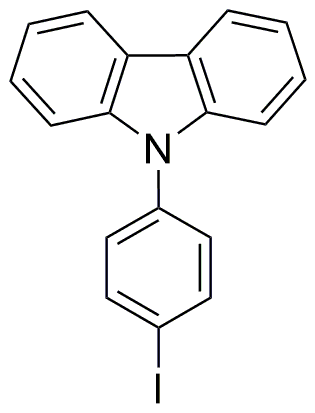9-(4-Iodophenyl)carbazole is widely utilized in research focused on:
- Organic Electronics: This compound is used in the development of organic light-emitting diodes (OLEDs), enhancing device efficiency and color purity.
- Photovoltaic Cells: It serves as a key material in organic solar cells, improving light absorption and energy conversion rates.
- Fluorescent Sensors: The compound is employed in creating sensors for detecting environmental pollutants, offering high sensitivity and selectivity.
- Pharmaceutical Research: It is explored for its potential in drug design, particularly in targeting specific cancer cells due to its unique structural properties.
- Material Science: This chemical is used in the synthesis of novel polymers, contributing to advancements in flexible electronics and high-performance materials.
General Information
Properties
Safety and Regulations
Applications
9-(4-Iodophenyl)carbazole is widely utilized in research focused on:
- Organic Electronics: This compound is used in the development of organic light-emitting diodes (OLEDs), enhancing device efficiency and color purity.
- Photovoltaic Cells: It serves as a key material in organic solar cells, improving light absorption and energy conversion rates.
- Fluorescent Sensors: The compound is employed in creating sensors for detecting environmental pollutants, offering high sensitivity and selectivity.
- Pharmaceutical Research: It is explored for its potential in drug design, particularly in targeting specific cancer cells due to its unique structural properties.
- Material Science: This chemical is used in the synthesis of novel polymers, contributing to advancements in flexible electronics and high-performance materials.
Documents
Safety Data Sheets (SDS)
The SDS provides comprehensive safety information on handling, storage, and disposal of the product.
Product Specification (PS)
The PS provides a comprehensive breakdown of the product’s properties, including chemical composition, physical state, purity, and storage requirements. It also details acceptable quality ranges and the product's intended applications.
Certificates of Analysis (COA)
Search for Certificates of Analysis (COA) by entering the products Lot Number. Lot and Batch Numbers can be found on a product’s label following the words ‘Lot’ or ‘Batch’.
*Catalog Number
*Lot Number
Certificates Of Origin (COO)
This COO confirms the country where the product was manufactured, and also details the materials and components used in it and whether it is derived from natural, synthetic, or other specific sources. This certificate may be required for customs, trade, and regulatory compliance.
*Catalog Number
*Lot Number
Safety Data Sheets (SDS)
The SDS provides comprehensive safety information on handling, storage, and disposal of the product.
DownloadProduct Specification (PS)
The PS provides a comprehensive breakdown of the product’s properties, including chemical composition, physical state, purity, and storage requirements. It also details acceptable quality ranges and the product's intended applications.
DownloadCertificates of Analysis (COA)
Search for Certificates of Analysis (COA) by entering the products Lot Number. Lot and Batch Numbers can be found on a product’s label following the words ‘Lot’ or ‘Batch’.
*Catalog Number
*Lot Number
Certificates Of Origin (COO)
This COO confirms the country where the product was manufactured, and also details the materials and components used in it and whether it is derived from natural, synthetic, or other specific sources. This certificate may be required for customs, trade, and regulatory compliance.


